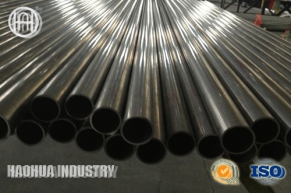Incoloy 901 (UNS N09901/Din 1.4898) steel pipes and tubes
Product Categary:
Main Feature:
Jiangsu Haohua Industry Group as one of the leading suppliers in China to supply Inconel 625 (UNS N06625/W.Nr.2.4856) staal pipes and tubes for petroleum industry and Heat Exchanger industry and Machining Industry etc.
product description
Inconel 625 (UNS N06625/W.Nr.2.4856) staal pipes and tubes
Incoloy 901 Chemical composition:
|
Alloy
|
%
|
Ni
|
Cu
|
Al |
Fe
|
Ti
|
Co
|
Mn
|
S
|
C
|
Si
|
P
|
Cr | Mo | B |
|
Incoloy 901
|
Min. |
40.0
|
|
|
2.35
|
|
|
|
|
|
|
11.0
|
5.0
|
0.01 |
|
|
Max.
|
45.0
|
0.50
|
0.35
|
Balance
|
3.10
|
1.0
|
1.0
|
0.03
|
0.10
|
0.60
|
0.03 |
14.0 |
7.0
|
0.02
|
Incoloy 901 Physical properties:
|
Density
|
8.14 g/cm3
|
|
Melting point
|
1280-1345℃
|
Incoloy 901 minimum mechanical properties in the room temperature:
|
Status
|
Tensile strength
Rm N/mm2 |
Yield strength
RP0.2N/mm2
|
Elongation
A5 %
|
|
Incoloy 901
|
1034
|
689
|
12
|
Description
A nickel-iron-chromium alloy containing titanium and aluminum for precipitation hardening and molybdenum for solid-solution strengthening. The alloy has high yield strength and creep resistance at temperatures to about 1110°F (600°C). A subtantial iron content enables the alloy to combine high strength with good forging characteristics. Used in gas turbines for discs and shafts. Standard products form is round.
A nickel-iron-chromium alloy containing titanium and aluminum for precipitation hardening and molybdenum for solid-solution strengthening. The alloy has high yield strength and creep resistance at temperatures to about 1110°F (600°C). A subtantial iron content enables the alloy to combine high strength with good forging characteristics. Used in gas turbines for discs and shafts. Standard products form is round.
Corrosion Resistance
Alloy 901 has good corrosion resistance to the atmospheres normally found in jet engine operations. It has slightly lower scaling resistance than such alloy as Types 309 and 310 stainless steel.
Workability
Hot Working
Alloy 901 is forged between 2050°F (1121°C) and 1850°F (1010°C), metal temperature. Light hot work may be continued down to 1600°F (871°C) but not below. Metal temperature should not exceed 2050°F (1121°C) during rapid working. Billets should be charged into a hot furnace and heated rapidly through the precipitation hardening range.
Weldability
Alloy 901 can be welded by the inert-gas-arc method. It is difficult to weld. All welding should be done in the solution treated condition. Cold worked parts should be re-solution treated before welding. A re-solution treatment is recommended after welding before stabilizing and aging.
Alloy 901 can be welded by the inert-gas-arc method. It is difficult to weld. All welding should be done in the solution treated condition. Cold worked parts should be re-solution treated before welding. A re-solution treatment is recommended after welding before stabilizing and aging.






